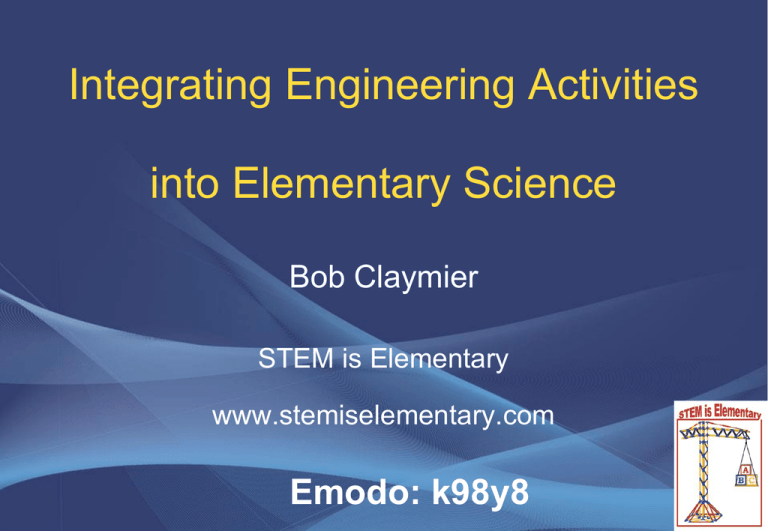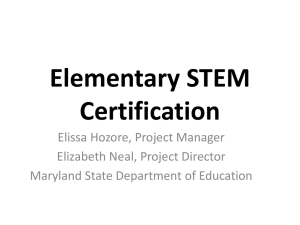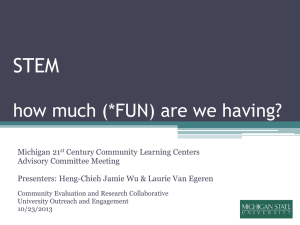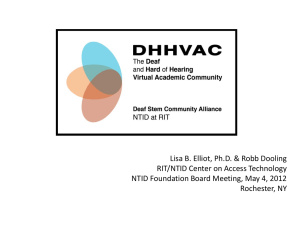OETC Powerpoint - STEM is Elementary
advertisement

Integrating Engineering Activities into Elementary Science Bob Claymier STEM is Elementary www.stemiselementary.com Emodo: k98y8 Goals of the Workshop • Why is STEM literacy important in the elementary grades? • How is the engineering design process used to teach a STEM lesson? • How do the engineering and scientific processes work together in designing a solution to a problem? • What resources are available for elementary STEM? 2 What is Technological Literacy? The use, management, understanding and assessment of technological products and processes. 3 What should a technologically literate person know and be able to do? http://www.cspnet.com/ Make well-informed choices in her role as a consumer What should a technologically literate person know and be able to do? AFP Photo / Justin Tallis Understand technological issues In order to make educated political decisions What should a technologically literate person know and be able to do? Understand technology’s impact on the environment, the economy, society and her personal life What should a technologically literate person know and be able to do? ISTOCKPHOTO / DAMALONEY Understand that science and technology are the foundation of our economic strength. What should a technologically literate person know and be able to do? spectrum.ieee.org Be more comfortable with and better prepared for new technologies that her job will demand What 21st Century Skills could be taught by STEM? Through STEM Literacy, Students: www.flindersaccounting.com Become risk-takers, see something that didn’t work as an as opportunity Through STEM Literacy, Students: www.pinterest.com More easily grasp abstract concepts and processes Through STEM Literacy, Students: 12 Can apply a variety of learning styles Through STEM Literacy, Students: fis-pyp-wiki.wikispaces.com 13 Transfer learning to several subjects and contexts Through STEM Literacy, Students: constructivisminelt.wikispaces.com 14 Become critical, divergent thinkers and “construct” their own knowldege By Teaching through STEM Integration, Teachers: www.husson.edu 15 Become facilitators, not centers of learning By Teaching through STEM Integration, Teachers: Develop technical reading, writing, and communication in students Can integrate STEM into many subjects and themes 16 By Teaching through STEM Integration, Teachers: Can meet varying student learning styles Can encourage new “stars” in the classroom Can make learning meaningful and engaging 17 What is a STEM lesson? • Problem Solving • Engineering Design Process • Redesign • Construction • Integration • Authentic 18 Learning Paper Engineering: Linkages O U T P U T = fixed point = movable point I N P U T Paper Engineering: Linkages O U T P U T = fixed point = movable point I N P U T Other Linkages OUTPUT INPUT I N P U T OUTPUT = fixed point = movable point I N P U T INPUT OUTPUT NGSS and Ohio Science Standards NGSS 3-LS4-2 Biological Evolution: Unity and Diversity Use evidence to construct an explanation for how the variations in characteristics among individuals of the same species may provide advantages in surviving, finding mates, and reproducing 22 NGSS and Ohio Science Standards Ohio Academic Standards for Science K: Physical and Behavioral Traits of Living Things K: Living things have physical traits and behaviors, which influence their survival. 23 Designing a STEM Lesson: Paper Engineered Animals Paper Engineered Animals Design Brief Challenge: Create a paper model animal with at least one moving body part and explain how that body part helps the animal survive Paper Engineered Animals Design Brief Criteria • Design must have at least one moving body part • Body part must be used by the animal to help it survive Constraints • Model must be no larger than 12” x 12” • Model must be made of only provided materials Paper Engineered Animals Design Brief Materials: • Cardstock • Brad paper fasteners • Hole punch • Scissors • Drawing materials (pencils, crayons) 27 What is the Engineering Design Process? Engineering is Elementary 28 What is the Engineering Design Process? 29 www.eie.org Using the Design Process to Guide the Lesson 1. Ask - Students identify the problem by: – restating the problem – Identifying criteria (requirements) and constraints (limits) for the project – Identify intended audience or client and method of presentation 30 Using the Design Process to Guide the Lesson 2. Imagine - Students investigate the problem by: - Asking questions – What structures do animals have and use? – How can I model that structure? - Doing research - How do animals move and eat? - What are some linkages models? 31 Using the Design Process to Guide the Lesson 2. Imagine - Students investigate the problem by: www.langevin.com 32 Brainstorming Other Linkages OUTPUT INPUT I N P U T OUTPUT = fixed point = movable point I N P U T INPUT OUTPUT Using the Design Process to Guide the Lesson 3. Plan - Students begin solving the problem by: – Choosing a final solution – Sketching the design – Gathering materials – Checking the design against the criteria and constraints 34 Using the Design Process to Guide the Lesson 3. Plan - Teacher: – Checks design and materials – Uses questioning techniques to help students rethink design before construction 35 Using the Design Process to Guide the Lesson 4. Create - Students: – Build the design – Test the design – Observe and collect data on the design 36 Using the Design Process to Guide the Lesson 5. Improve - Students present and modify the solution by: – Presenting the solution to their audience – Receiving feedback on the design – Modifying the design based on the feedback 37 Paper Engineering: Other Curriculum Connections Language Arts: • Following directions Social Studies • Structures • Journal writing • Inventions • Illustrating a story Physical Education/Health • How body joints works • Levers in sports equipment 38 Paper Engineering: Science Concepts • Force and motion- change of direction • Properties of materials • Input and output • Animal structure and habitats; cell structure • Illustrate natural cycles and changes • Earth and Space (seasons, planets, weather, water, landforms) • Life cycles • Chemical and physical changes Paper Engineering: Math, Technology, and Engineering Skills and Concepts Math Engineering • Measurement • Applying math and science • Symmetry to solve a problem • Geometric concepts • Mechanical advantage • Using the engineering design process Technology • Meeting a want or need Science and Engineering Scientists use tools to learn about the natural environment Engineers use scientific discoveries and knowledge to create new designs and solve problems Engineering Design Process Scientific Inquiry Tangient LLC Scientific Inquiry vs. Engineering Design Scientific Inquiry Engineering Design State a question or problem about the natural world Gather information Define a problem or need to be solved in the human-made world Gather information Formulate hypothesis, identify variables Design experiment, establish procedures Test hypothesis multiple times Establish design criteria Analyze results, draw conclusions Analyze results, verify, redesign and retest Present results Present results 44 Prepare preliminary designs Build and test a prototype Science and Technology Science and Engineering Science and technology affect society and the environment People make decisions that guide science and engineering Scientific Inquiry and the Engineering Design Process David Haury Learning Science Through Design Bernie Zubrowski Integrating Science into Design Technology Projects: Using a Standard Model in the Design Process 46 Elementary STEM Resources www.stemiselementary.com 47 Elementary STEM Resources www.stemiselementary.com 48 April 17, 1 – 4 PM, Marion, OH www.stemiselementary.com 49 Elementary STEM Resources www.tecchome.org 50 Elementary STEM Resources www.eie.org 51 Elementary STEM Resources 52 Elementary STEM Resources 53 http://www.snap-circuits.com/ 54 https://mymakedo.com Elementary STEM Resources www.kevaplanks.com 55 Elementary STEM Resources www.littlebits.cc 56 Elementary STEM Resources http://www.nationalstemcentre.org.uk https://nsdl.oercommons.org 57 References Engineering is Elementary, Museum of Science, Boston, The Difference Between Science and Engineering. http://eie.org/eiecurriculum/resources/difference-betweenscience-and-engineering 58 References Haury, David. Learning Science Through Design. ERIC Digest, Clearinghouse for Science, Mathematics, and Environmental Education, October 2002 59 References Zubrowski, Bernard. Integrating Science into Design Technology Projects: Using a Standard Model in the Design Process. Journal of Technology Education, Vol. 13 No. 2, Spring 2002 60 Goals of the Workshop • Why is STEM literacy important in the elementary grades? • How is the engineering design process used to teach a STEM lesson? • How do the engineering and scientific processes work together in designing a solution to a problem? • What resources are available for elementary STEM? 61 Bob Claymier www.stemiselementary.com 62








